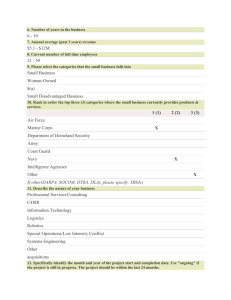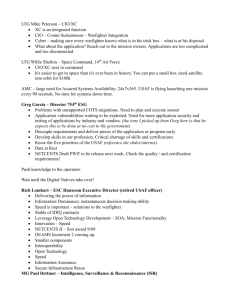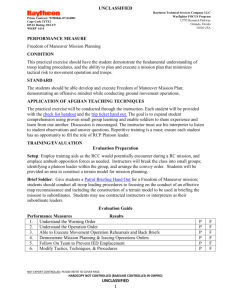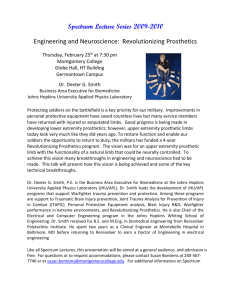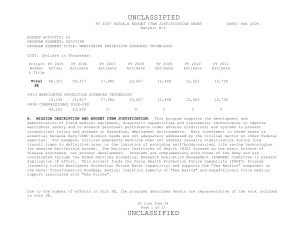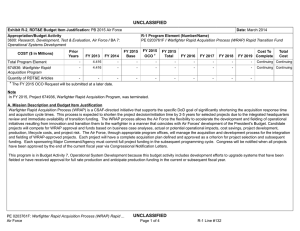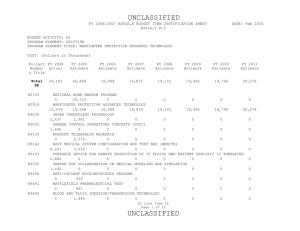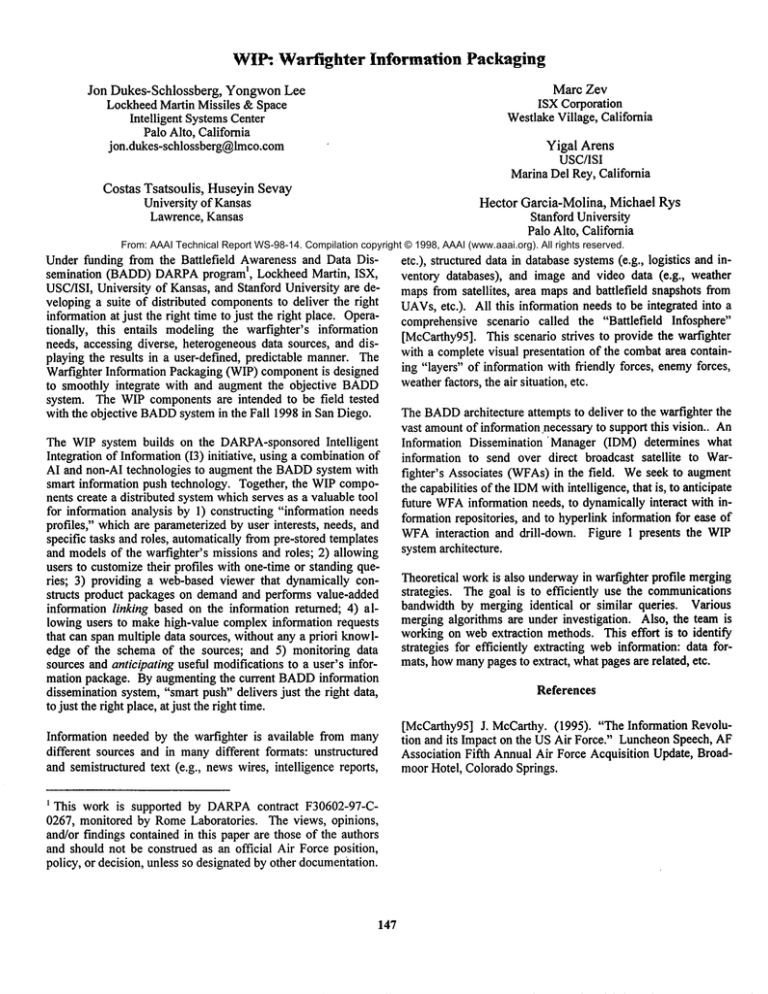
WIP:. Warfighter Information Packaging
Marc Zev
ISX Corporation
WestlakeVillage, California
Jon Dukes-Schlossberg,
Yongwon Lee
Lockheed Martin Missiles & Space
Intelligent SystemsCenter
Palo Alto, California
jon.dukes-schlossberg@lmco.com
Yigal Arens
USC/ISI
Marina Del Rey, California
Costas Tsatsoulis, Huseyin Sevay
University of Kansas
Lawrence, Kansas
Hector Garcia-Molina, Michael Rys
Stanford University
Palo Alto, California
From: AAAI Technical Report WS-98-14. Compilation copyright © 1998, AAAI (www.aaai.org). All rights reserved.
Under funding from the Battlefield Awareness and Data Dissemination (BADD)DARPAprogramI, Lockheed Martin, ISX,
USC/ISI, University of Kansas, and Stanford University are developing a suite of distributed componentsto deliver the right
information at just the right time to just the right place. Operationally, this entails modeling the warfighter’s information
needs, accessing diverse, heterogeneous data sources, and displaying the results in a user-defined, predictable manner. The
Warfighter Information Packaging (WIP) componentis designed
to smoothly integrate with and augment the objective BADD
system. The WIP components are intended to be field tested
with the objective BADD
system in the Fall 1998 in San Diego.
The WIPsystem builds on the DARPA-sponsoredIntelligent
Integration of Information (13) initiative, using a combination
AI and non-AI technologies to augment the BADD
system with
smart information push technology. Together, the WIPcomponents create a distributed system whichserves as a valuable tool
for information analysis by 1) constructing "information needs
profiles," which are parameterized by user interests, needs, and
specific tasks and roles, automatically from pre-stored templates
and models of the warfighter’s missions and roles; 2) allowing
users to customize their profiles with one-time or standing queries; 3) providing a web-based viewer that dynamically constructs product packages on demand and performs value-added
information linking based on the information returned; 4) allowing users to make high-value complex information requests
that can span multiple data sources, without any a priori knowledge of the schema of the sources; and 5) monitoring data
sources and anticipating useful modifications to a user’s information package. By augmenting the current BADD
information
dissemination system, "smart push" delivers just the right data,
to just the right place, at just the right time.
Information needed by the warfighter is available from many
different sources and in manydifferent formats: unstructured
and semistructured text (e.g., news wires, intelligence reports,
1This work is supported by DARPAcontract F30602-97-C0267, monitored by RomeLaboratories. The views, opinions,
and/or findings contained in this paper are those of the authors
and should not be construed as an official Air Force position,
policy, or decision, unless so designated by other documentation.
147
etc.), structured data in database systems(e.g., logistics and inventory databases), and image and video data (e.g., weather
maps from satellites, area maps and battlefield snapshots from
UAVs,etc.). All this information needs to be integrated into
comprehensive scenario called the "Battlefield Infosphere"
[McCarthy95].This scenario strives to provide the warfighter
with a complete visual presentation of the combatarea containing "layers" of information with friendly forces, enemyforces,
weatherfactors, the air situation, etc.
The BADD
architecture attempts to deliver to the warfighter the
vast amountof information necessary to support this vision.. An
Information Dissemination ’Manager (IDM) determines what
information to send over direct broadcast satellite to Warfighter’s Associates (WFAs)in the field. Weseek to augment
the capabilities of the IDMwith intelligence, that is, to anticipate
future WFA
information needs, to dynamically interact with information repositories, and to hyperlink information for ease of
WFAinteraction and drill-down. Figure I presents the WIP
systemarchitecture.
Theoretical work is also underwayin warfighter profile merging
strategies. The goal is to efficiently use the communications
bandwidth by merging identical or similar queries. Various
merging algorithms are under investigation. Also, the team is
working on web extraction methods. This effort is to identify
strategies for efficiently extracting webinformation: data formats, howmanypages to extract, what pages are related, etc.
References
[McCarthy95] J. McCarthy. (1995). "The Information Revolution and its Impact on the USAir Force." LuncheonSpeech, AF
Association Fifth Annual Air Force Acquisition Update, Broadmoor Hotel, Colorado Springs.
all
~t
l,
4
,It
4P
t
~t
t,
b
C ¯
Figure 1. Warfighter Information Packaging Architecture. User modeling, information anticipation, data source access, and product
packagingsmoothlyintegrate to present the warfighter with just the right information at just the right time.
mation Analysis Tool." in Proceedings of AIPA98,Washington,
DC, March, 1998.
Selected Recent TeamPublications
Yigal Arens, YongwonLee, Jon Dukes-Schlossberg, and Marc
Zev. "Warfighter’s Information Packager: Making Delivered
Data Useful." Innovative Applications of Artificial Intelligence,
IAAI-98, Madison, WI, August, 1998.
S. Chawathe, H. Garcia-Molina. Meaningful Change Detection
in Structured Data. SIGMOD
1997, 1997.
J. Cho , H. Garcia-Molina , L. Page. Efficient Crawling
Through URLOrdering . In Proceedings of 7th World Wide
WebConference, 1998.
Jon Dukes-Schlossberg,
Yongwon Lee, and Nancy Lehrer.
"lIDS: Intelligent Information Dissemination Server." In Proceedings of MILCOM
’97, Monterey, CA, November, 1997.
J. Hammer,H. Garcia-Molina, J. Cho, R. Aranha, A. Crespo.
Extracting Semistructured Information from the Web. In Proceedings of the Workshop on Managementof Semistructured
Data. Tucson, Arizona, May1997.
Marc Zev, Yigal Arens, Yongwon Lee, and Jon DukesSchlossberg. "Warfighter Information Packaging as an Infor-
148


